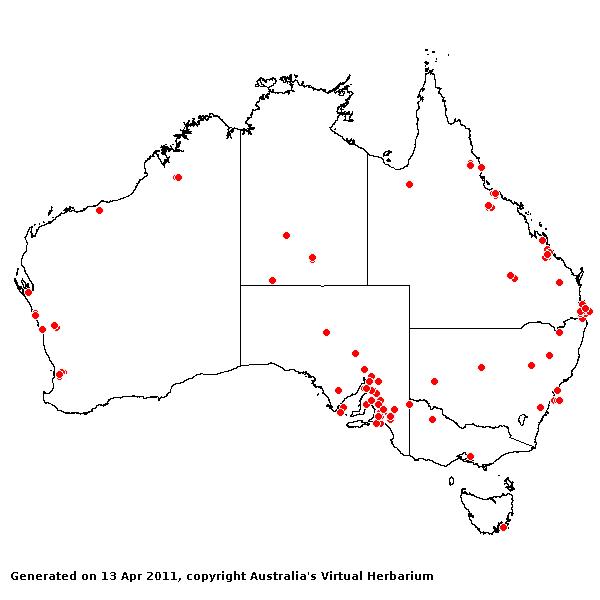Cenchrus setaceus* (Forsk.) Chiov. Boll.
Soc. Bot. Ital. 113 (1923).
Classification. (GPWG 2001) : Subfamily
Panicoideae. Paniceae.
Basionym and/or
Replacement Name: Phalaris
setacea Forssk., Fl. Aegypt.-Arab. 17 (1775).
Type of Basionym or
Protologue Information: T: Forsskål s.n., Egypt: Cairo (?).
Recent synonyms:
Pennisetum setaceum.
Key references
(books and floras): [1952] C.A.Gardner, Flora of Western Australia 1
Gramineae (280 as P. oreintale), [2002] D.Sharp & B.K.Simon, AusGrass,
Grasses of Australia as Pennisetum setaceum, [2006] J.Jessop, G.R.M.Dashorst, F.M.James, Grasses
of South Australia (472) as Pennisetum setaceum, [2008] S.W.L.Jacobs, R.D.B.Walley &
D.J.B.Wheeler, Grasses of New South Wales (334) as Pennisetum setaceum.
Illustrations:
[2006] J.Jessop, G.R.M.Dashorst, F.M.James, Grasses of South Australia (473, Fig. 406) as Pennisetum setaceum, [2008] S.W.L.Jacobs,
R.D.B.Whalley & D.J.B.Wheeler, Grasses of New South Wales, 4th edn
(334) as Pennisetum setaceum.
Habit. Perennial. Rhizomes present. Stolons absent. Culms 20–150 cm tall.
Ligule a fringe of hairs. Leaf-blades convolute, 15–30 cm long, 1–3 mm wide.
Inflorescence.
Inflorescence solid, a panicle. Panicle linear, 6–30 cm long.
Spikelets.
Spikelets sessile and pedicelled, 1–3 in the cluster. Involucre composed of
bristles. Fertile spikelets 2-flowered, the lower floret barren (rarely male),
the upper fertile, comprising 1 basal sterile florets, comprising 1 fertile
floret(s), without rachilla extension or with a barren rachilla extension,
lanceolate, dorsally compressed, 4.5–6.5 mm long.
Glumes. Glumes
dissimilar, thinner than fertile lemma. Lower glume ovate or orbicular,
hyaline, without keels, 0 -nerved. Upper glume lanceolate or ovate, membranous,
without keels, 1 -nerved. Upper glume surface asperulous. Upper glume apex
mucronate. Florets. Basal sterile florets 1, male or barren, with palea
or without significant palea. Lemma of lower sterile floret 100 % of length of
spikelet, membranous, 1–3(–5) -nerved, mucronate.
Fertile lemma 4.5–6.5
mm long, without keel, 5 -nerved. Lodicules absent or vestigial. Anthers 3.
Continental
Distribution: Europe, Africa, Temperate Asia, Australasia, and Pacific.
Australian
Distribution: Western Australia, South Australia, Queensland, New South
Wales, Victoria.
Western Australia:
Drummond. South Australia: Gairdner-Torrens Basin, Flinders Ranges, Eyre
Peninsula, Northern Lofty, Murray, Yorke Peninsula, Southern Lofty,
South-eastern. Queensland: Burke, Cook, Moreton, North Kennedy, Port
Curtis, Leichhardt. New South Wales: Central Coast, North-Western
Slopes, South-Western Slopes, North-Western Plains, North Far Western Plains,
South Far Western Plains. Victoria: Gippsland Plain.
Notes.
A prolongation of the callus and the incomplete reduction of the primary branch
produces a pronounced stipe. In some species the bristles do not form a
involucre.
Introduced. In
tropical and subtropical sub-humid woodlands, semi-arid shrub woodlands, and
coastal grasslands. Flowers sporadically throughout the year.
![[Australian Distribution 2002 © ABRS]](/files/1peset.gif)




